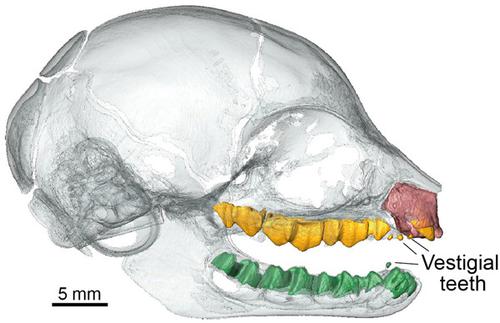当前位置:
X-MOL 学术
›
Evol. Dev.
›
论文详情
Our official English website, www.x-mol.net, welcomes your
feedback! (Note: you will need to create a separate account there.)
Developmental origins and homologies of the hyracoid dentition.
Evolution and Development ( IF 2.6 ) Pub Date : 2020-04-30 , DOI: 10.1111/ede.12337 Helder Gomes Rodrigues 1, 2, 3 , Rodolphe Tabuce 3 , Robert J Asher 4 , Lionel Hautier 3, 4, 5
Evolution and Development ( IF 2.6 ) Pub Date : 2020-04-30 , DOI: 10.1111/ede.12337 Helder Gomes Rodrigues 1, 2, 3 , Rodolphe Tabuce 3 , Robert J Asher 4 , Lionel Hautier 3, 4, 5
Affiliation

|
Understanding the origins of morphological specializations in mammals is a key goal in evolutionary biology. It can be accomplished by studying dental homology, which is at the core of most evolutionary and developmental studies. Here, we focused on the evolution and development of the specialized dentition of hyraxes for which dental homologies have long been debated, and could have implications on early placental evolution. Specifically, we analysed dental mineralization sequences of the three living genera of hyraxes and 17 fossil species using X‐ray computed microtomography. Our results point out the labile position of vestigial upper teeth on jaw bones in extant species, associated with the frequently unusual premolar shape of deciduous canines over 50 Ma of hyracoid evolution. We proposed two evolutionary and developmental hypotheses to explain these original hyracoid dental characteristics. (a) The presence of a vestigial teeth on the maxilla in front of a complex deciduous canine could be interpreted as extra‐teeth reminiscent of early placental evolution or sirenians, an order phylogenetically close to hyracoids and showing five premolars. (b) These vestigial teeth could also correspond to third incisors with a position unusually shifted on the maxilla, which could be explained by the dual developmental origin of these most posterior incisors and their degenerated condition. This integrative study allows discussion on the current evolutionary and developmental paradigms associated with the mammalian dentition. It also highlights the importance of nonmodel species to understand dental homologies.
中文翻译:

丘状齿列的发展起源和同源性。
了解哺乳动物形态学专业的起源是进化生物学的关键目标。可以通过研究牙齿同源性来完成,这是大多数进化和发育研究的核心。在这里,我们专注于蹄兔专用牙列的演变和发展,长期以来人们一直在讨论其牙齿同源性,并且可能对早期胎盘的发展有影响。具体来说,我们使用X射线计算机断层扫描技术分析了非洲蹄兔和17个化石物种的三个活属的牙齿矿化序列。我们的研究结果表明,现存物种中残留的上颌牙齿在颚骨上的不稳定位置,与超过50 Ma的类门齿演化的落叶犬的前磨牙形状常常不同。我们提出了两个进化和发展假说来解释这些原始的类腮环牙齿特征。(a)在一个复杂的乳牙犬前的上颌骨上有一个残留的牙齿,可以解释为齿外牙齿让人想起胎盘的早期发育或海妖,这是一个在系统发育上接近类比龙眼并显示五个前磨牙的顺序。(b)这些残余牙也可能对应于第三切牙,其在上颌骨上的位置异常移动,这可以由这些最后切牙的双重发育起源及其退化状况来解释。这项综合研究允许讨论与哺乳动物牙列相关的当前进化和发展范例。它还强调了非模型物种对理解牙齿同源性的重要性。
更新日期:2020-04-30
中文翻译:

丘状齿列的发展起源和同源性。
了解哺乳动物形态学专业的起源是进化生物学的关键目标。可以通过研究牙齿同源性来完成,这是大多数进化和发育研究的核心。在这里,我们专注于蹄兔专用牙列的演变和发展,长期以来人们一直在讨论其牙齿同源性,并且可能对早期胎盘的发展有影响。具体来说,我们使用X射线计算机断层扫描技术分析了非洲蹄兔和17个化石物种的三个活属的牙齿矿化序列。我们的研究结果表明,现存物种中残留的上颌牙齿在颚骨上的不稳定位置,与超过50 Ma的类门齿演化的落叶犬的前磨牙形状常常不同。我们提出了两个进化和发展假说来解释这些原始的类腮环牙齿特征。(a)在一个复杂的乳牙犬前的上颌骨上有一个残留的牙齿,可以解释为齿外牙齿让人想起胎盘的早期发育或海妖,这是一个在系统发育上接近类比龙眼并显示五个前磨牙的顺序。(b)这些残余牙也可能对应于第三切牙,其在上颌骨上的位置异常移动,这可以由这些最后切牙的双重发育起源及其退化状况来解释。这项综合研究允许讨论与哺乳动物牙列相关的当前进化和发展范例。它还强调了非模型物种对理解牙齿同源性的重要性。











































 京公网安备 11010802027423号
京公网安备 11010802027423号